Socio-Ecological Perceptions of Wildfire Management and Effects in Greece
Abstract
:1. Introduction
2. Materials and Methods
2.1. The Greek Landscape
2.2. Key Informant Survey
3. Results
3.1. Sample Structure and Information
3.2. General Perceptions on Fire Prevention and Management
3.3. Perceptions on Post-Fire Effects
3.4. Differences Between Expert and Non-Expert Respondents
4. Discussion and Conclusions
Supplementary Materials
Author Contributions
Funding
Acknowledgments
Conflicts of Interest
References
- Palaiologou, P.; Ager, A.A.; Nielsen-Pincus, M.; Evers, C.; Kalabokidis, K. Using transboundary wildfire exposure assessments to improve fire management programs: A case study in Greece. Int. J. Wildland Fire 2018, 27, 501–513. [Google Scholar] [CrossRef]
- Greek Government. The 2020 Greek Forest Service Budget, YPEN/DPDP/53540/1554/05.06.2020. Available online: https://diavgeia.gov.gr/doc/%CE%A8%CE%9B%CE%A6%CE%9A4653%CE%A08-%CE%95%CE%98%CE%9A?inline=true (accessed on 7 July 2020).
- Greek Government. The 2020 Local Government Budget for Wildfire Protection, ΩΚΓΔ46ΜΤΛ6-ΝΣ2/26258. Available online: https://diavgeia.gov.gr/doc/%CE%A9%CE%9A%CE%93%CE%9446%CE%9C%CE%A4%CE%9B6-%CE%9D%CE%A32?inline=true (accessed on 7 July 2020).
- Kalabokidis, K.; Palaiologos, P.; Xanthopoulos, G. Pyro-geography of the Greek landscape. In The Geography of Greece: Managing Crises and Building Resilience; Darques, R., Ed.; Springer: Dordrecht, The Netherlands, in press.
- EFFIS. European Forest Fire Information System, Joint Research Centre: Forest Fires in Europe, Middle East and North Africa; European Commission, Publications Office: Luxembourg, 2020. [Google Scholar]
- Palaiologou, P.; Kalabokidis, K.; Ager, A.A.; Day, M.A. Development of comprehensive fuel management strategies for reducing wildfire risk in Greece. Forests 2020, 11, 789. [Google Scholar] [CrossRef]
- Goupos, C.; Papastaurou, C. Legal restrictions on forest ownership in Greece. In Forging a New Framework for Sustainable Forestry: Recent Developments in European Forest Law; IUFRO World Series; ETH: Zurich, Switzerland, 2000; Volume 10, pp. 156–161. [Google Scholar]
- Benayas, J.R.; Martins, A.; Nicolau, J.M.; Schulz, J.J. Abandonment of agricultural land: An overview of drivers and consequences. CAB Rev. Perspect. Agric. Vet. Sci. Nutr. Nat. Resour. 2007, 2, 1–14. [Google Scholar] [CrossRef] [Green Version]
- MacDonald, D.; Crabtree, J.R.; Wiesinger, G.; Dax, T.; Stamou, N.; Fleury, P.; Gutierrez Lazpita, J.; Gibon, A. Agricultural abandonment in mountain areas of Europe: Environmental consequences and policy response. J. Environ. Manag. 2000, 59, 47–69. [Google Scholar] [CrossRef]
- Zakkak, S.; Kakalis, E.; Radović, A.; Halley, J.M.; Kati, V. The impact of forest encroachment after agricultural land abandonment on passerine bird communities: The case of Greece. J. Nat. Conserv. 2014, 22, 157–165. [Google Scholar] [CrossRef]
- Tedim, F.; Xanthopoulos, G.; Leone, V. Chapter 5—Forest fires in Europe: Facts and challenges A2. In Wildfire Hazards, Risks and Disasters; Paton, D., Shroder, J.F., Eds.; Elsevier: Oxford, UK, 2015; pp. 77–99. [Google Scholar] [CrossRef]
- Cavounidis, J. Migration and the economic and social landscape of Greece. South East. Eur. J. Econ. 2013, 11, 59–78. [Google Scholar]
- Salvati, L. Bridging the divide: Demographic dynamics and urban–rural polarities during economic expansion and recession in Greece. Popul. Space Place 2019, 25, e2267. [Google Scholar] [CrossRef]
- Arianoutsou, M. Landscape changes in Mediterranean ecosystems of Greece: Implications for fire and biodiversity issues. J. Mediterr. Ecol. 2001, 2, 165–178. [Google Scholar]
- Thompson, K. Farm Fragmentation in Greece: The Problem and Its Setting: With 11 Village Case Studies; C. Serbinis Press: Athens, Greece, 1963; p. 263. [Google Scholar]
- Kasimis, C.; Venturas, L.; Ziomas, D. Greece: Social Impact of Emigration and Rural-Urban Migration in Central and Eastern Europe; European Commission: Brussels, Belgium, 2012; p. 3. [Google Scholar]
- Close, D.H. Greece since 1945: Politics, Economy and Society; Routledge: Oxfordshire, UK, 2014. [Google Scholar]
- Tsilimigkas, G.; Kizos, T. Space, pressures and the management of the Greek landscape. Geogr. Ann. Ser. B Hum. Geogr. 2014, 96, 159–175. [Google Scholar] [CrossRef]
- Henderson, M.; Kalabokidis, K.; Marmaras, E.; Konstantinidis, P.; Marangudakis, M. Fire and society: A comparative analysis of wildfire in Greece and the United States. Hum. Ecol. Rev. 2005, 12, 169–182. [Google Scholar]
- Kalabokidis, K.; Iosifides, T.; Henderson, M.; Morehouse, B. Wildfire policy and use of science in the context of a socio-ecological system on the Aegean Archipelago. Εnviron. Sci. Policy 2008, 11, 408–421. [Google Scholar] [CrossRef]
- Morehouse, B.J.; Henderson, M.; Kalabokidis, K.; Iosifides, T. Wildland Fire Governance: Perspectives from Greece. J. Environ. Policy Plan. 2011, 13, 349–371. [Google Scholar] [CrossRef]
- Papanikolaou, V.; Adamis, D.; Mellon, R.C.; Prodromitis, G.; Kyriopoulos, J. Trust, social and personal attitudes after wildfires in a rural region of Greece. Sociol. Mind. 2012, 2, 87. [Google Scholar] [CrossRef] [Green Version]
- Xanthopoulos, G. People and the mass media during the fire disaster days of 2007 in Greece. In Proceedings of the International Bushfire Research Conference Fire, Environment and Society, Adelaide, Australia, 1–3 September 2008; p. 14. [Google Scholar]
- EEA. Corine Land Cover (CLC) 2018; Version 2020_20u1; 12 July 2013; European Environment Agency: Copenhagen, Denmark, 2018. [Google Scholar]
- Papanastasis, V.P.; Mantzanas, K.; Dini-Papanastasi, O.; Ispikoudis, I. Traditional agroforestry systems and their evolution in Greece. In Agroforestry in Europe: Current Status and Future Prospects; Rigueiro-Rodróguez, A., McAdam, J., Mosquera-Losada, M.R., Eds.; Springer: Dordrecht, The Netherlands, 2009; pp. 89–109. [Google Scholar]
- Tsagari, K.; Karetsos, G.; Proutsos, N. Wildfire in Greece, 1983–2008; WWF Hellas and NAGREF: Athens, Greece, 2011; p. 112. [Google Scholar]
- Qualtrics, Qualtrics, Provo, Utah, USA. 2018. Available online: https://www.qualtrics.com/blog/citing-qualtrics/ (accessed on 1 April 2021).
- Ingalsbee, T. Whither the paradigm shift? Large wildland fires and the wildfire paradox offer opportunities for a new paradigm of ecological fire management. Int. J. Wildland Fire 2017, 26, 557. [Google Scholar] [CrossRef]
- Berger, C.; Fitzgerald, S.; Leavell, D. Managing wildfire for resource benefit: What is it and is it beneficial? In Fire FAQs; Oregon State University Extension Service: Corvallis, OR, USA, 2018. [Google Scholar]
- Huffman, D.W.; Roccaforte, J.P.; Springer, J.D.; Crouse, J.E. Restoration applications of resource objective wildfires in western US forests: A status of knowledge review. Fire Ecol. 2020, 16, 1–13. [Google Scholar] [CrossRef]
- De Montmollin, B.; Strahm, W. The Top 50 Mediterranean Island Plants: Wild Plants at the Brink of Extinction, and What Is Needed to Save Them; De Montmollin, B., Strahm, W., Eds.; IUCN: Gland, Switzerland; Cambridge, UK, 2005. [Google Scholar]
- Pamperis, L.N. The Butterflies of Greece; Bastas-Plessas Graphic Arts SA: Athens, Greece, 1997. [Google Scholar]
- Xanthopoulos, G.; Athanasiou, M.; Kazakis, G.; Ghosn, D.; Kaoukis, K. Backfire and its use in Greece. In Proceedings of the 19th Greek Forestry Conference, Litochoro, Greece, 29 September–2 October 2019; pp. 255–267. [Google Scholar]
- Smith, A.M.S.; Strand, E.K. Recognizing Women Leaders in Fire Science: Revisited. Fire 2018, 1, 45. [Google Scholar] [CrossRef] [Green Version]
- Boustras, G.; Boukas, N. Forest fires’ impact on tourism development: A comparative study of Greece and Cyprus. Manag. Environ. Qual. 2013, 24, 498–511. [Google Scholar] [CrossRef]
- Xanthopoulos, G.; Athanasiou, M.; Zirogiannis, N. Use of fire for wildfire suppression during the fires of 2007 in Greece. In Proceedings of the 2nd International Conference on Fire Behaviour and Risk, Sardinia, Italy, 26–29 May 2015; pp. 26–29. [Google Scholar]
- Tsaliki, L. Technologies of political mobilization and civil society in Greece: The wildfires of summer 2007. Convergence 2010, 16, 151–161. [Google Scholar] [CrossRef] [Green Version]
- Hovardas, T. “Playing with Fire” in a Pre-Election Period: Newspaper Coverage of 2007 Wildfires in Greece. Soc. Nat. Resour. 2014, 27, 689–705. [Google Scholar] [CrossRef]
- Hovardas, T. An “Asymmetric Threat” That Should Have Been Anticipated: Political Discourse on 2007 Wildfires in Greece. Environ. Commun. 2015, 9, 409–427. [Google Scholar] [CrossRef]
- Xanthopoulos, G.; Viegas, D.X.; Caballero, D. The fatal fire entrapment of Artemida (Greece) 2007. In Recent Forest Fire Related Accidents in Europe; Viegas, D.X., Ed.; Office for Official Publications of the European Communities: Luxembourg, 2009; EUR 24121 EN; pp. 65–75. [Google Scholar]
- Papanastasis, V.P.; Kazaklis, A. Land use changes and conflicts in the Mediterranean-type ecosystems of western Crete. In Landscape Disturbance and Biodiversity in Mediterranean-Type Ecosystems; Rundel, P.W., Montenegro, G., Jaksic, F.M., Eds.; Springer: Berlin/Heidelberg, Germany, 1998; pp. 141–154. [Google Scholar]
- Nielsen-Pincus, M.; Moseley, C.; Gebert, K. Job growth and loss across sectors and time in the western US: The impact of large wildfires. For. Policy Econ. 2014, 38, 199–206. [Google Scholar] [CrossRef] [Green Version]
- Nielsen-Pincus, M.; Moseley, C.; Gebert, K. The effects of large wildfires on employment and wage growth and volatility in the western United States. J. For. 2013, 111, 404–411. [Google Scholar] [CrossRef]
- Paliatsos, A.G.; Amanatidis, G.T. Smoke concentrations in Athens, Greece: Trends and strong episodes, 1984–1991. Sci. Total Environ. 1994, 144, 137–144. [Google Scholar] [CrossRef]
- Sofiou, F.; Amiridis, V.; Mihalopoulos, N. Smoke plume characteristics over Greece using space-based multiangle imaging. In Proceedings of the First International Conference on Remote Sensing and Geoinformation of the Environment (RSCy2013), Paphos, Cyprus, 10 April 2013; p. 87950D. [Google Scholar]
- Richardson, L.A.; Champ, P.A.; Loomis, J.B. The hidden cost of wildfires: Economic valuation of health effects of wildfire smoke exposure in Southern California. J. For. Econ. 2012, 18, 14–35. [Google Scholar] [CrossRef]
- Kochi, I.; Donovan, G.H.; Champ, P.A.; Loomis, J.B. The economic cost of adverse health effects from wildfire-smoke exposure: A review. Int. J. Wildland Fire 2010, 19, 803–817. [Google Scholar] [CrossRef]
- Thanos, C.Á.; Doussi, M.A. Post-fire regeneration of Pinus brutia forests. In Ecology, Biogeography and Management of Pinus halepensis and P. brutia Forest Ecosystems in the Mediterranean Basin; Backhuys Publishers: Leiden, The Netherlands, 2000; pp. 291–301. [Google Scholar]
- Spanos, I.A.; Radoglou, K.M.; Raftoyannis, Y. Site Quality Effects on Post-Fire Regeneration of Pinus brutia Forest on a Greek Island. Appl. Veg. Sci. 2001, 4, 229–236. [Google Scholar] [CrossRef]
- Kosmas, C.; Gerontidis, S.; Marathianou, M. The effect of land use change on soils and vegetation over various lithological formations on Lesvos (Greece). CATENA 2000, 40, 51–68. [Google Scholar] [CrossRef]
- Palaiologou, P.; Tsiourlis, G.; Kalabokidis, K.; Krallis, F.; Konstantinidis, P. Regeneration of burned Pinus brutia ecosystems in Greece. In Proceedings of the 2nd International Conference on Fire Behaviour and Risk, Sardinia, Italy, 26–29 May 2015. [Google Scholar]
- European Commission, Directorate-General for Climate Action. Special Eurobarometer 459: Climate Change; European Union: Brussels, Belgium, 2017; p. 101. [Google Scholar]
- Estrada, M.; Schultz, P.W.; Silva-Send, N.; Boudrias, M.A. The role of social influences on pro-environment behaviors in the San Diego region. J. Urban Health 2017, 94, 170–179. [Google Scholar] [CrossRef] [Green Version]
- Lorimer, J. Wildlife in the Anthropocene: Conservation after Nature; University of Minnesota Press: Minneapolis, MN, USA, 2015. [Google Scholar]
- Milner-Gulland, E.J.; McGregor, J.A.; Agarwala, M.; Atkinson, G.; Bevan, P.; Clements, T.; Daw, T.; Homewood, K.; Kumpel, N.; Lewis, J.; et al. Accounting for the Impact of Conservation on Human Well-Being. Conserv. Biol. 2014, 28, 1160–1166. [Google Scholar] [CrossRef]
- Chan, K.M.A.; Guerry, A.D.; Balvanera, P.; Klain, S.; Satterfield, T.; Basurto, X.; Bostrom, A.; Chuenpagdee, R.; Gould, R.; Halpern, B.S.; et al. Where are Cultural and Social in Ecosystem Services? A Framework for Constructive Engagement. BioScience 2012, 62, 744–756. [Google Scholar] [CrossRef]
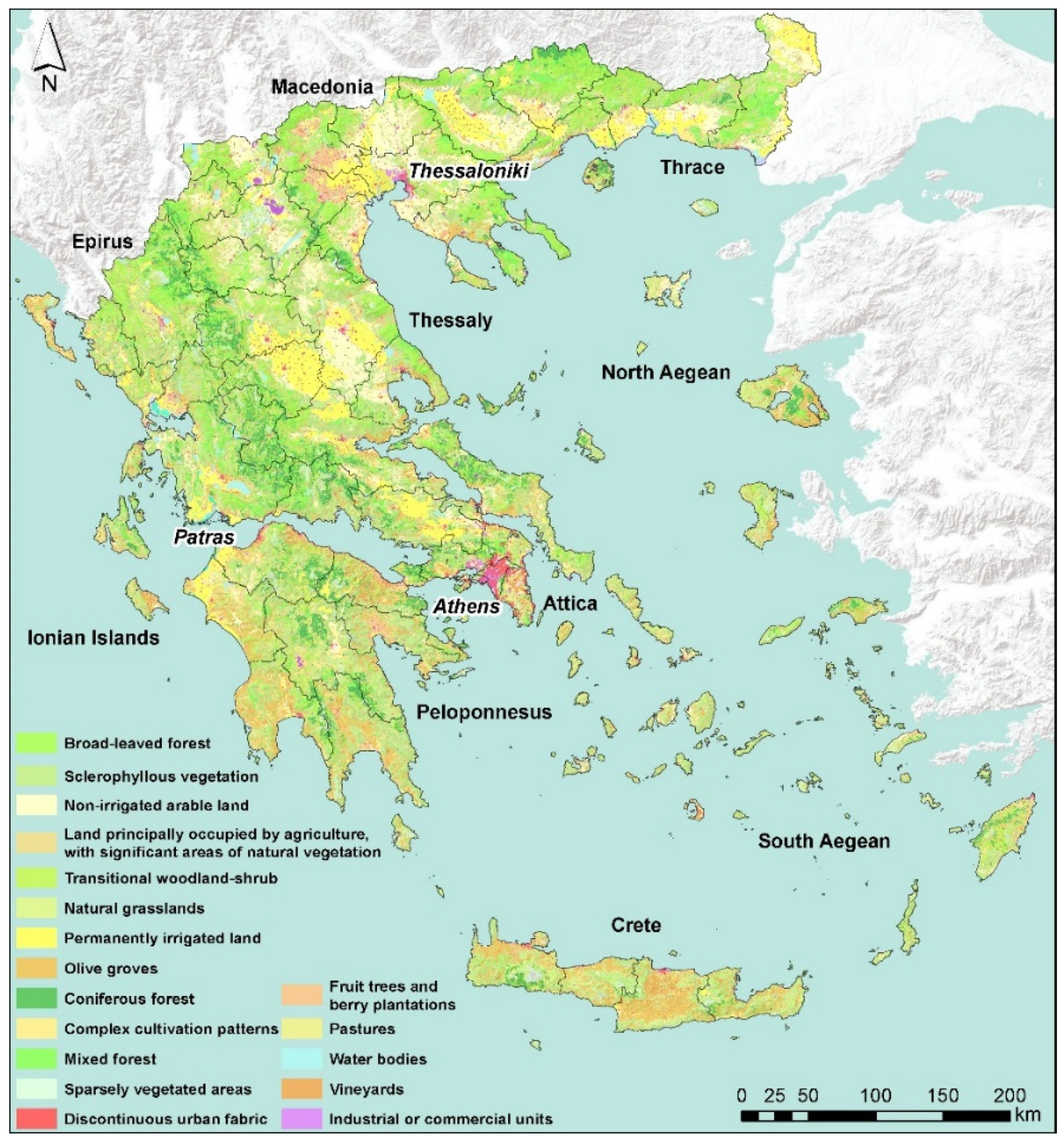
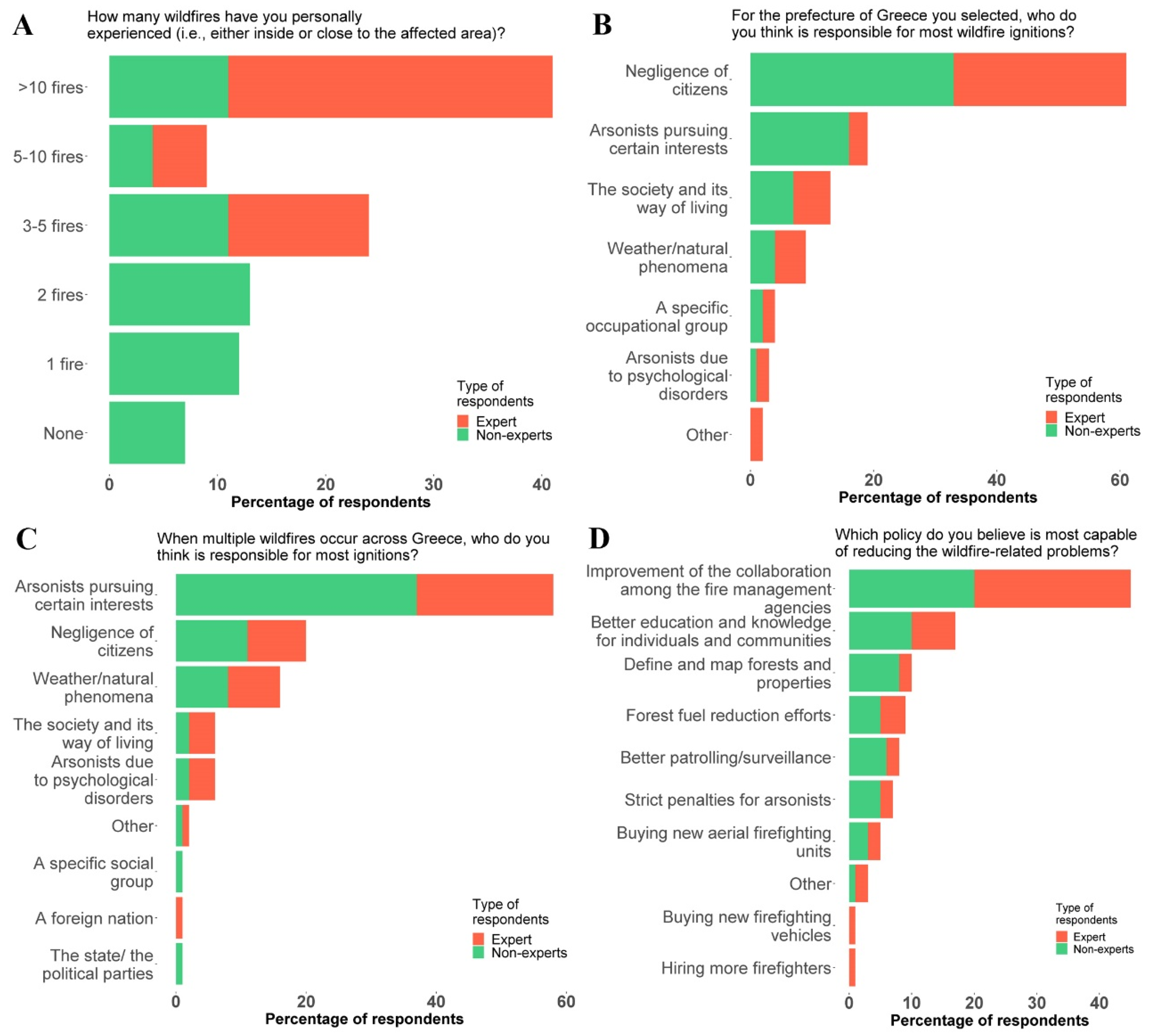

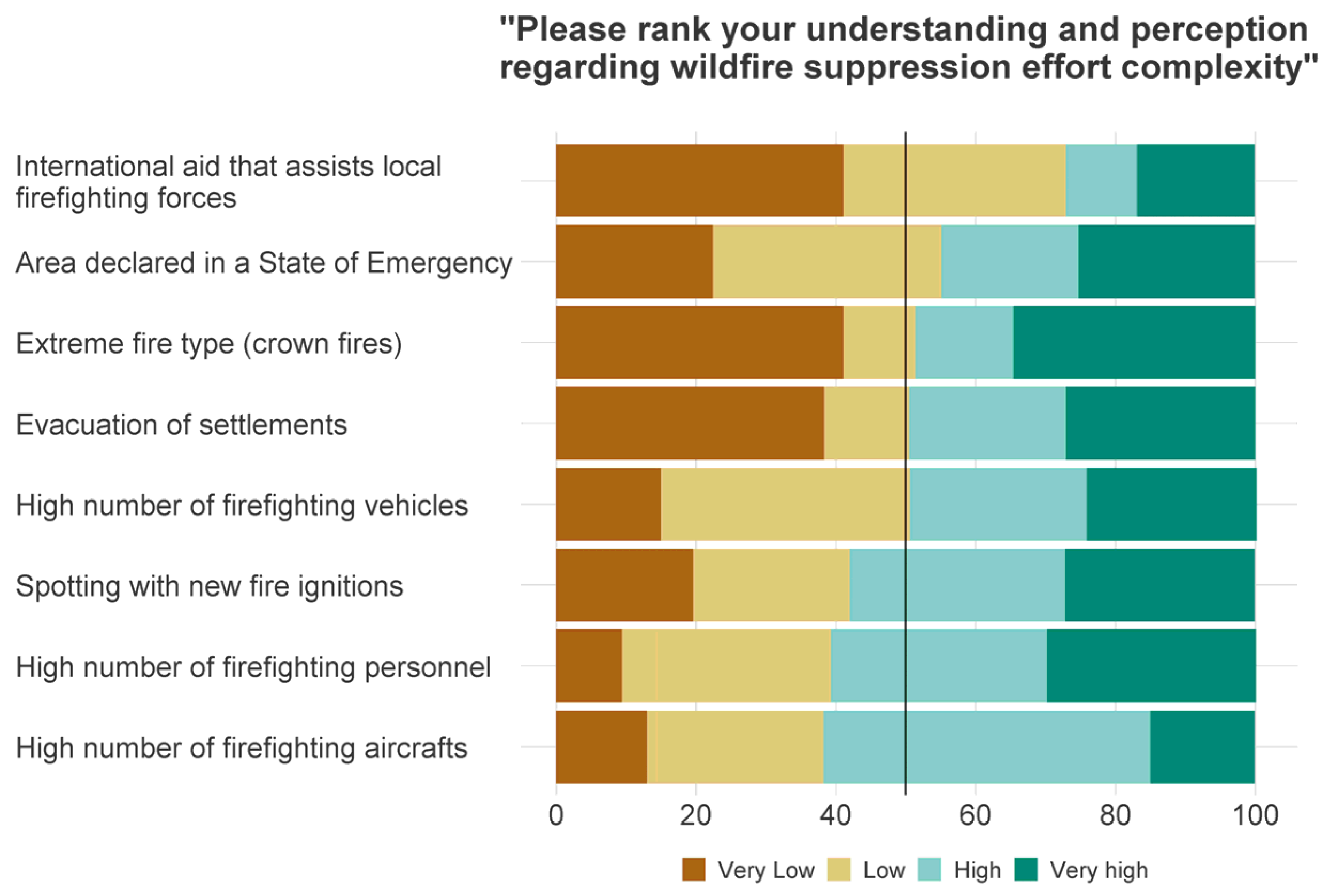
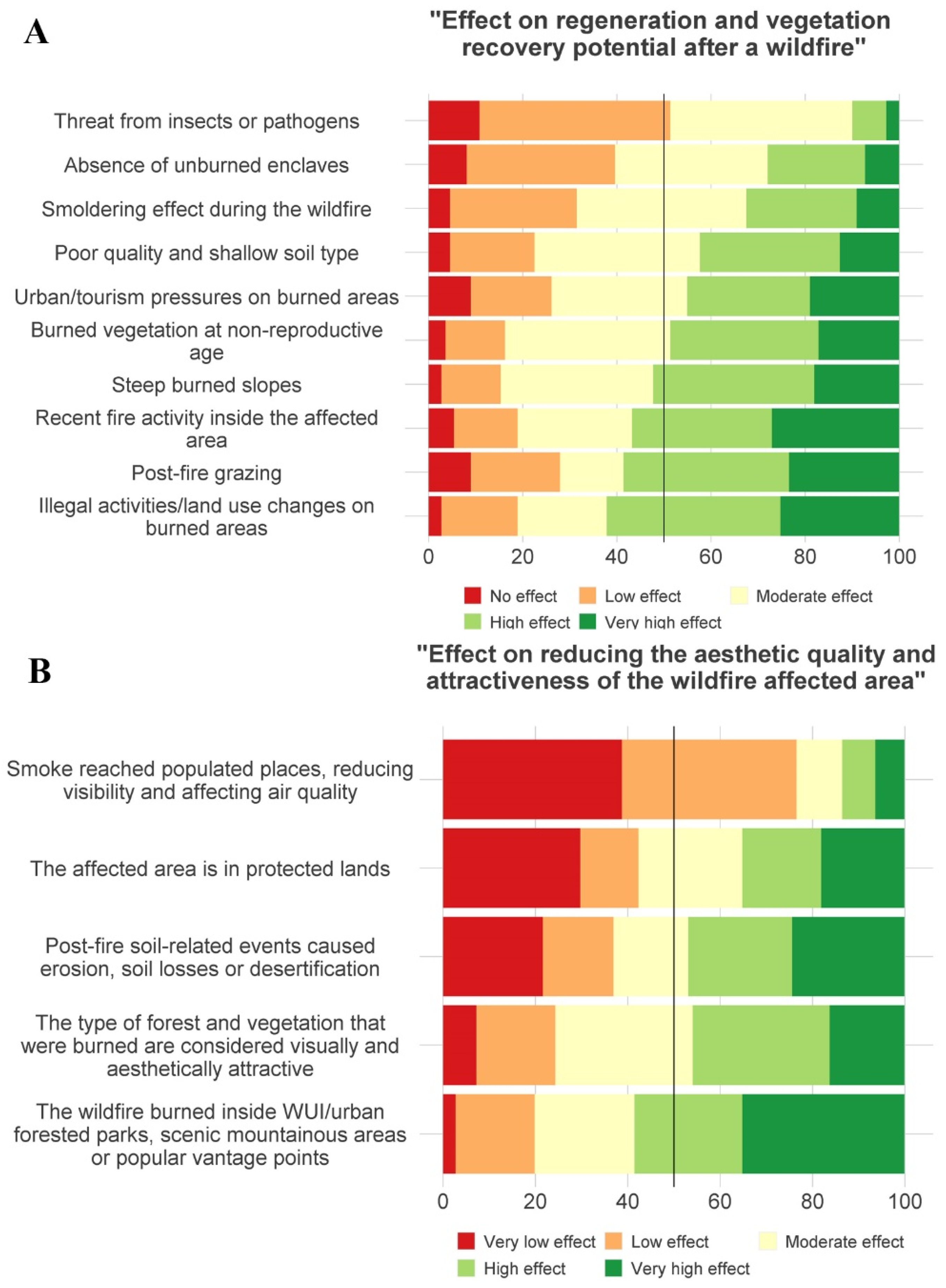

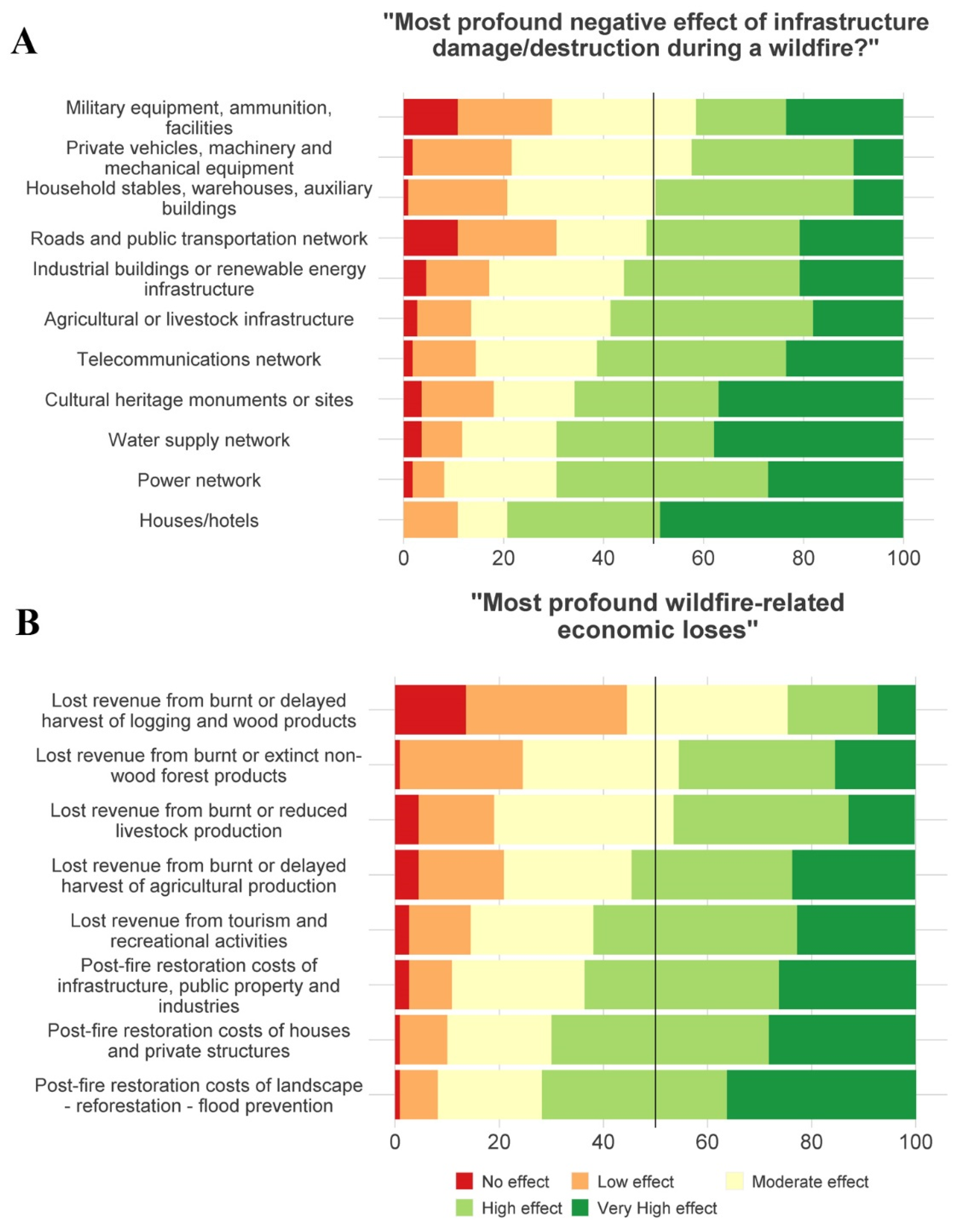
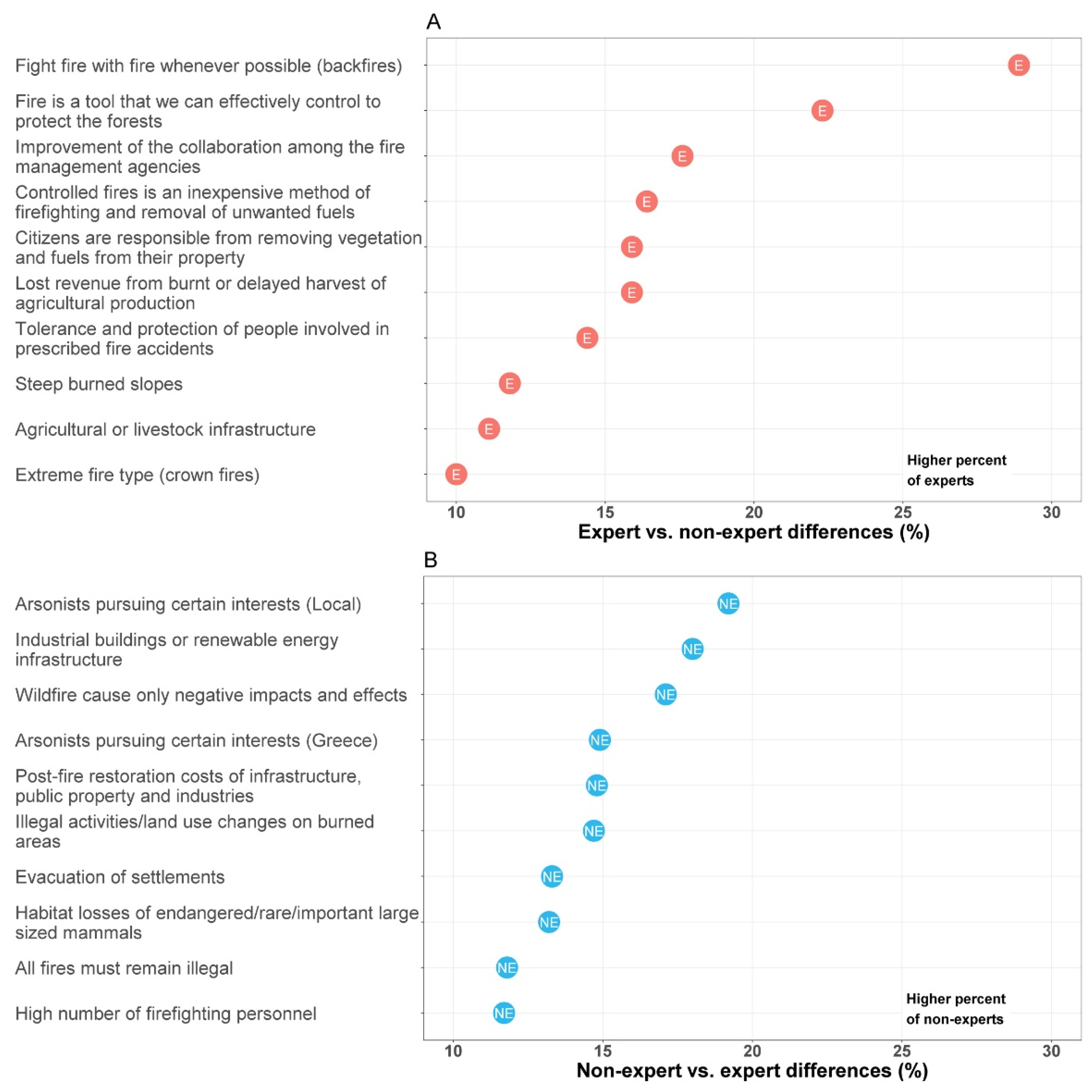
| Personal Questions | General Questions and Beliefs on Fire Prevention/Management | Rating or Ranking of Different Fire Effects | |||||
|---|---|---|---|---|---|---|---|
| Q1.1 In which part of Greece did you reside in the longest? (A) | Q2.1 For the prefecture of Greece you selected, who do you think is responsible for most wildfire ignitions? (B) | Q3.1 Based on your experience and knowledge, please rate the effect of the following negative factors on reducing regeneration and vegetation recovery potential after a wildfire, for the prefecture of Greece where you have resided the longest. (E) | |||||
| Q1.2 How many wildfires have you personally experienced (i.e., either inside or close to the affected area)? (B) | Q2.2 When multiple wildfires occur across Greece, who do you think is responsible for most ignitions? (B) | Q3.2 Based on your experience and knowledge, please rate the importance of the following wildfire effects on the environment, for the prefecture of Greece where you have resided the longest. (F) | |||||
| Q1.3 Please rate your experience with wildfires (G) | Q2.3 Please rank your understanding and perception regarding wildfire suppression effort complexity (C) | Q3.3 Please rank the following factors based on their effect on reducing the aesthetic quality and attractiveness of the affected area after a wildfire, for the prefecture of Greece where you have resided the longest. (C) | |||||
| Q1.4 Employment status (B) | Q2.4 What is your opinion on using controlled fire during firefighting or as prescribed fire to reduce forest fuels? (H) | Q3.4 How are you personally impacted when human health and lives are affected by a wildfire? (D) | |||||
| Q1.5 If you are employed, where do you work? (B) | Q2.5 What is your opinion on the specific wildfire-related statements? (H) | Q3.5 How are you personally impacted when casualties of firefighting personnel occur during a wildfire? (D) | |||||
| Q1.6 Age class (B) | Q2.6 Which policy do you believe is most capable of reducing the wildfire-related problems? (B) | Q3.6 Which type of infrastructure damage or destruction that can happen during a wildfire can have the most profound negative effect on the prefecture of Greece where you have resided the longest? (E) | |||||
| Q1.7 Highest degree you have received (B) | Q3.7 Which economic losses that can happen after a wildfire can have the most profound negative effect on the prefecture of Greece where you have resided the longest? (E) | ||||||
| Q1.8 Gender (B) | Q3.8 Rank the five wildfire effects questions from most (1) to least (7) important as to their contribution to describing overall wildfire effects. (C) | ||||||
| A: Drill Down | B: Multiple Choice: one answer | C: Ranking Order | D: Matrix, Lowest to Highest Impact | E: Matrix, No Effect to Very High Effect | F: Matrix, Not Important to Extremely Important | G: Matrix, No Experience to Very High Experience | H: Matrix, Strongly Disagree to Strongly Agree |
| Socio- | Classes or Category | % of Class | Mean Sample | SD Sample | Skewness | Kurtosis | S-W 3 Test | Valid N |
|---|---|---|---|---|---|---|---|---|
| Demographic Components | ||||||||
| Gender | Male | 79.2 | 0.21 | 0.407 | 1.463 | 0.143 | ns | 106 |
| Female | 20.8 | |||||||
| Age | 18–24 | 1.9 | ||||||
| 25–34 | 31.4 | |||||||
| 35–44 | 17.1 | 3.35 | 1.24 | 0.346 | −0.585 | ns | 105 | |
| 45–54 | 35.3 | |||||||
| 55–64 | 7.6 | |||||||
| 65–74 | 6.7 | |||||||
| Education level | High school graduate | 4.8 | ||||||
| Two-year studies | 3.8 | |||||||
| Four-year studies | 39 | 3.7 | 1.126 | −0.258 | −0.104 | ns | 105 | |
| Professional studies | 23.8 | |||||||
| Doctorate | 25.7 | |||||||
| Other 1 | 2.9 | |||||||
| Employment | Student | 6.7 | ||||||
| Full-time employed | 76.3 | |||||||
| Retired | 6.6 | 2.29 | 0.968 | 2.444 | 6.699 | ns | 105 | |
| Unemployed, in search | 6.6 | |||||||
| Unemployed | - | |||||||
| Part-time employed | 3.8 | |||||||
| Job condition | Inactive 2 | 21 | ||||||
| Fire Service | 32.4 | |||||||
| Expatriate employees | 2.9 | |||||||
| Central Government | 11.4 | |||||||
| Private sector | 6.7 | 3.45 | 2.236 | 0.589 | −1.013 | ns | 105 | |
| Self-employed | 12.4 | |||||||
| Research—University | 10.5 | |||||||
| Research—Government | 1.9 | |||||||
| Research—Private | 1 |
Publisher’s Note: MDPI stays neutral with regard to jurisdictional claims in published maps and institutional affiliations. |
© 2021 by the authors. Licensee MDPI, Basel, Switzerland. This article is an open access article distributed under the terms and conditions of the Creative Commons Attribution (CC BY) license (https://creativecommons.org/licenses/by/4.0/).
Share and Cite
Palaiologou, P.; Kalabokidis, K.; Troumbis, A.; Day, M.A.; Nielsen-Pincus, M.; Ager, A.A. Socio-Ecological Perceptions of Wildfire Management and Effects in Greece. Fire 2021, 4, 18. https://0-doi-org.brum.beds.ac.uk/10.3390/fire4020018
Palaiologou P, Kalabokidis K, Troumbis A, Day MA, Nielsen-Pincus M, Ager AA. Socio-Ecological Perceptions of Wildfire Management and Effects in Greece. Fire. 2021; 4(2):18. https://0-doi-org.brum.beds.ac.uk/10.3390/fire4020018
Chicago/Turabian StylePalaiologou, Palaiologos, Kostas Kalabokidis, Andreas Troumbis, Michelle A. Day, Max Nielsen-Pincus, and Alan A. Ager. 2021. "Socio-Ecological Perceptions of Wildfire Management and Effects in Greece" Fire 4, no. 2: 18. https://0-doi-org.brum.beds.ac.uk/10.3390/fire4020018







